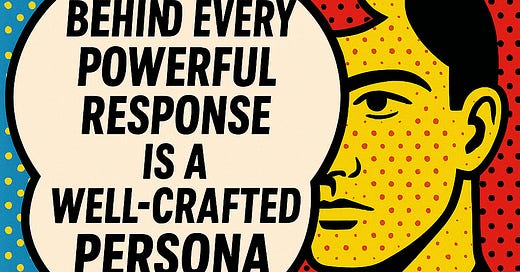Behind every powerful response is a well-crafted Persona.
Basic Role Definition Strategies and Techniques in System Prompt Design
In system prompt design, clearly defining the role or persona of the AI—what it is supposed to be or act as—is a crucial factor that directly impacts the quality of its responses. Role setting goes far beyond simply assigning a job title. It’s about designing how the AI solves problems, communicates, and interacts with users. Below are key strategies and techniques to define roles effectively in system prompt design, along with illustrative examples.
1. Purpose-Driven Role Definition: “What is the AI solving?”
Core Technique:
Begin by transforming the user's vague request into a clear problem-solving objective. The more specific the purpose, the clearer the AI’s role. For instance, instead of asking “Give me design feedback,” refining it to “Give feedback that improves readability while maintaining brand tone” instantly sets a sharper purpose.
Example:
✅ Vague role: “Give advice as a marketing expert.”
🔍 Clear role: “Act as a D2C startup marketing strategist and suggest improvements focused on increasing email conversion rates.”
With this clarity, the AI shifts from being a generic advisor to a purpose-specific strategist.
2. Designing Cognitive Frames: “How should the AI think?”
Core Technique:
A role isn't just a title—it includes the thinking style, decision-making logic, and prioritization framework the AI should follow. This ensures responses are consistent and logically grounded, rather than fragmented.
Example:
“You're a business consultant” → Too generic
“You're a consultant who evaluates startup business models based on market structure, customer journey, and cost structure” → With a strategic cognitive frame
Such framing enhances the depth and coherence of AI-generated responses.
3. Controlling Tone and Diction: “How should this role communicate?”
Core Technique:
When defining a role, you should also specify its linguistic characteristics—word choice, sentence length, emotional tone. This affects how trustworthy, friendly, or authoritative the AI feels to the user.
Example:
“You’re a mental health counselor. Instead of being overly analytical, acknowledge the user's emotions first and then gently guide them.”
With this approach, the AI not only delivers useful content but also builds emotional rapport with users.
4. Dynamic Role Shifting Based on Context
Core Technique:
Rather than fixing the AI to a single role, design prompts to allow contextual shifts in roles depending on the stage of the interaction. This requires building a prompt flow that progressively changes the persona.
Example:
“Analyze the customer journey from a marketing expert’s point of view.”
“Now explain the same journey from the customer’s perspective.”
“Finally, synthesize both perspectives as a brand strategist.”
This multi-role structure helps the AI deliver layered, multi-angle insights.
5. A/B Prompt Testing for Role Optimization
Core Technique:
Even with the same data, different roles can produce dramatically different responses. Use A/B testing to identify which role delivers the most useful, actionable, or creative output.
Example:
Compare responses from:
A data analyst
A business consultant
A marketing strategist
Whichever role produces the most insightful and usable results becomes a candidate for template optimization.
6. Role Definition Within Model Constraints
Core Technique:
Design roles that align with the AI model’s token limits and processing logic. Overly complex or mixed roles can confuse the model and degrade output quality. Simplicity with semantic richness is key.
Example:
❌ “You are a marketing expert, designer, and psychologist.”
✅ “You are a marketing expert who considers how visual messages affect consumer emotions.”
This technique allows the AI to function effectively within its computational boundaries.
7. Collaborative Role Adjustment: Co-creating the Persona with the User
Core Technique:
Sometimes, the AI’s performance may drift from expectations. In these cases, build in meta-instructions so the AI can self-diagnose or ask for feedback, adjusting its role as needed in real-time.
Example:
“If I start sounding too theoretical, let me know.”
“If my role seems misaligned with your needs, say ‘Role adjustment needed.’”
This fosters a more collaborative and adaptive interaction model.
Final Thoughts: Role Design is a Philosophy of Dialogue
In system prompt design, defining a role is not merely saying, “You are X.” It’s about instilling the AI with a philosophy of how to interpret the world, solve problems, and engage with people.
Structuring and fine-tuning this philosophy is what ultimately transforms AI into a meaningful, context-aware partner.
Let me know if you’d like to build on this by turning it into a template system or a role design matrix for your projects. I'd be happy to help with that too.



